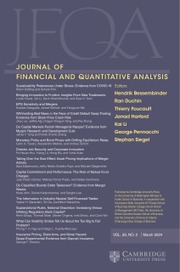No CrossRef data available.
Article contents
Compensation Consultants: Whom Do They Serve? Evidence from Consultant Changes
Published online by Cambridge University Press: 14 March 2025
Abstract
We investigate whether compensation consultants recommend excessive pay to earn repeat business by studying consultant changes. Our results show consultants’ interests are aligned with shareholders’ to appropriately pay the CEO. Boards dismiss consultants making large pay recommendation errors, particularly positive ones. However, powerful or poorly monitored CEOs interfere with such disciplinary turnover, weakening the relation. Peer groups are more likely to change with new consultant appointments. New consultants are less likely to include highly paid executives in the compensation peer group and CEO pay falls following the change. Directors earn higher votes in annual elections when they replace compensation advisors.
Information
- Type
- Research Article
- Information
- Creative Commons
- This is an Open Access article, distributed under the terms of the Creative Commons Attribution licence (http://creativecommons.org/licenses/by/4.0), which permits unrestricted re-use, distribution and reproduction, provided the original article is properly cited.
- Copyright
- © The Author(s), 2025. Published by Cambridge University Press on behalf of the Michael G. Foster School of Business, University of Washington
Footnotes
We are appreciative of helpful comments from Nik Augustin, Daewoung Choi (discussant), Alex Edmans, Steve Ferris, Emmanuel Sequeira (discussant), Matthew Serfling, Ralph Walkling, and Betty Wu (discussant). We are especially grateful for the feedback provided by an anonymous reviewer. We would also like to thank the seminar and conference participants at the University of Missouri, the Eastern Finance Association’s (EFA) annual meeting, the Financial Management Association’s (FMA) annual meeting, and the Southern Finance Association’s (SFA) annual meeting for their helpful suggestions.

